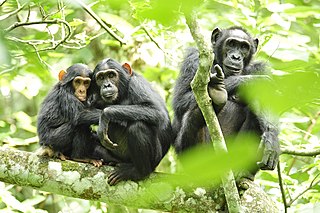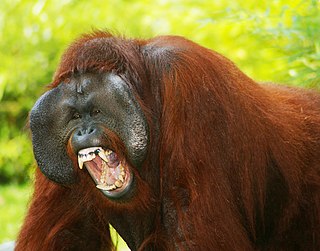Related Research Articles

Primates is an order of mammals, which is further divided into the strepsirrhines, which include lemurs, galagos, and lorisids; and the haplorhines, which include tarsiers; and the simians, which include monkeys and apes. Primates arose 85–55 million years ago first from small terrestrial mammals, which adapted for life in tropical forests: many primate characteristics represent adaptations to the challenging environment among tree tops, including large brain sizes, binocular vision, color vision, vocalizations, shoulder girdles allowing a large degree of movement in the upper limbs, and opposable thumbs that enable better grasping and dexterity. Primates range in size from Madame Berthe's mouse lemur, which weighs 30 g (1 oz), to the eastern gorilla, weighing over 200 kg (440 lb). There are 376–524 species of living primates, depending on which classification is used. New primate species continue to be discovered: over 25 species were described in the 2000s, 36 in the 2010s, and six in the 2020s.

In primatology, the Machiavellian intelligence or social brain hypothesis describes the capacity of primates to manuever in complex social groups. The first introduction of this concept came from Frans de Waal's book Chimpanzee Politics (1982). In the book de Waal notes that chimpanzees performed certain social maneuvering behaviors that reminded him of the works of Machiavelli.

Washoe was a female common chimpanzee who was the first non-human to learn to communicate using some American Sign Language (ASL) as part of an animal research experiment on animal language acquisition.

Franciscus Bernardus Maria de Waal was a Dutch-American primatologist and ethologist. He was the Charles Howard Candler Professor of Primate Behavior in the Department of Psychology at Emory University in Atlanta, Georgia, director of the Living Links Center at the Yerkes National Primate Research Center at Emory, and author of numerous books including Chimpanzee Politics (1982) and Our Inner Ape (2005). His research centered on primate social behavior, including conflict resolution, cooperation, inequity aversion, and food-sharing. He was a member of the United States National Academy of Sciences and the Royal Netherlands Academy of Arts and Sciences.

Animal cognition encompasses the mental capacities of non-human animals including insect cognition. The study of animal conditioning and learning used in this field was developed from comparative psychology. It has also been strongly influenced by research in ethology, behavioral ecology, and evolutionary psychology; the alternative name cognitive ethology is sometimes used. Many behaviors associated with the term animal intelligence are also subsumed within animal cognition.

Animal languages are forms of communication between animals that show similarities to human language. Animals communicate through a variety of signs, such as sounds and movements. Signing among animals may be considered a form of language if the inventory of signs is large enough. The signs are relatively arbitrary, and the animals seem to produce them with a degree of volition.
The origin of language, its relationship with human evolution, and its consequences have been subjects of study for centuries. Scholars wishing to study the origins of language must draw inferences from evidence such as the fossil record, archaeological evidence, contemporary language diversity, studies of language acquisition, and comparisons between human language and systems of animal communication. Many argue that the origins of language probably relate closely to the origins of modern human behavior, but there is little agreement about the facts and implications of this connection.

Research into great ape language has involved teaching chimpanzees, bonobos, gorillas and orangutans to communicate with humans and each other using sign language, physical tokens, lexigrams, and imitative human speech. Some primatologists argue that the use of these communication methods indicate primate "language" ability, though this depends on one's definition of language. The cognitive tradeoff hypothesis suggests that human language skills evolved at the expense of the short-term and working memory capabilities potentially observed in other hominids.
The Mind of an Ape is a 1983 book by David Premack and his wife Ann James Premack. The authors argue that it is possible to teach language to (non-human) great apes. They write: "We now know that someone who comprehends speech must know language, even if he or she cannot produce it."
A talking animal or speaking animal is any non-human animal that can produce sounds or gestures resembling those of a human language. Several species or groups of animals have developed forms of communication which superficially resemble verbal language, however, these usually are not considered a language because they lack one or more of the defining characteristics, e.g. grammar, syntax, recursion, and displacement. Researchers have been successful in teaching some animals to make gestures similar to sign language, although whether this should be considered a language has been disputed.

The evolutionary origin of religion and religious behavior is a field of study related to evolutionary psychology, the origin of language and mythology, and cross-cultural comparison of the anthropology of religion. Some subjects of interest include Neolithic religion, evidence for spirituality or cultic behavior in the Upper Paleolithic, and similarities in great ape behavior.

Primate cognition is the study of the intellectual and behavioral skills of non-human primates, particularly in the fields of psychology, behavioral biology, primatology, and anthropology.

Josep Call is a Spanish comparative psychologist specializing in primate cognition.
Deep social mind is a concept in evolutionary psychology; it refers to the distinctively human capacity to 'read' the mental states of others while reciprocally enabling those others to read one's own mental states at the same time. The term 'deep social mind' was first coined in 1999 by Andrew Whiten, professor of Evolutionary and Developmental Psychology at St. Andrews University, Scotland. Together with closely related terms such as 'reflexivity' and 'intersubjectivity', it is now well-established among scholars investigating the evolutionary emergence of human sociality, cognition and communication.
David Andrew Whiten, known as Andrew Whiten is a British zoologist and psychologist, Professor of Evolutionary and Developmental Psychology, and Professor Wardlaw Emeritus at University of St Andrews in Scotland. He is known for his research in social cognition, specifically on social learning, tradition and the evolution of culture, social Machiavellian intelligence, autism and imitation, as well as the behavioral ecology of sociality. In 1996, Whiten and his colleagues invented an artificial fruit that allowed to study learning in apes and humans.
Theory of mind in animals is an extension to non-human animals of the philosophical and psychological concept of theory of mind (ToM), sometimes known as mentalisation or mind-reading. It involves an inquiry into whether non-human animals have the ability to attribute mental states to themselves and others, including recognition that others have mental states that are different from their own. To investigate this issue experimentally, researchers place non-human animals in situations where their resulting behavior can be interpreted as supporting ToM or not.

Pointing is a gesture specifying a direction from a person's body, usually indicating a location, person, event, thing or idea. It typically is formed by extending the arm, hand, and index finger, although it may be functionally similar to other hand gestures. Types of pointing may be subdivided according to the intention of the person, as well as by the linguistic function it serves.
Catherine (Cat) Hobaiter is a British-Lebanese primatologist focusing on social behaviour in wild chimpanzees and involved in long-term studies of chimpanzees in the Budongo Forest Reserve in Uganda and the MoyenBafing National Park in Guinea. She is particularly interested in the role gestures play in communication. She is a Reader at the University of St Andrews.
Malinda Carpenter,Ph.D, FRSE is a professor of developmental psychology at the University of St Andrews, an international researcher specialising in infant and child communications, prosocial behaviour and group reactions, in how people learn to understand others, and building self esteem; her work includes research between ape and human social cognition, and more recently in considering human-robotic communication futures.
Simone Susanne Pika is a German ethologist and primatologist investigating the evolution and development of language, cognition and plasticity by focusing on distinct model systems such as corvids, great apes, monkeys and dolphins. Since 2017, she co-directs the Ozouga Chimpanzee Project, Loango National Park in Gabon. She is a full professor at the Institute of Cognitive Science, Osnabrück University, Germany.
References
- ↑ "Richard William Byrne". Research at St Andrews. Retrieved 16 April 2021.
- ↑ "Richard Byrne". Google Scholar. Retrieved 16 April 2021.